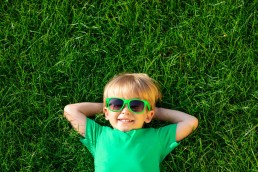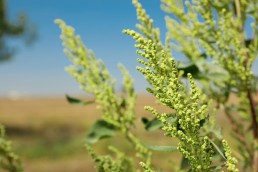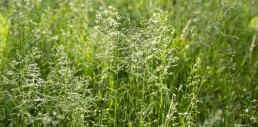Summer Allergies
What do you look forward to in the summer months? I bet it isn't summer allergies! Whether you are planning to be the grill master or the ultimate host of the patio celebration, we have tips to help you prepare. Today, let’s discuss some common summer allergens you may encounter when enjoying the sun or attending summer celebrations.
During the summer months, many allergy sufferers are wary of grass pollen. They are the most common seasonal allergy triggers and are heaviest in May through August. Don't forget to check local pollen counts to determine the density of pollen in the air on any given day. Read more about Grass Pollen Allergies and avoidance tip in our blog post here.
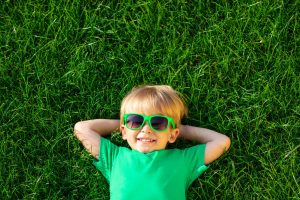
Skin Reactions
With many summer celebrations occurring outside or around the pool, sunscreen is important to discuss. We all know sunscreen is a crucial part of summer safety, but sometimes it can cause a reaction much worse than a sunburn. Individuals can have a contact allergy to the sunscreen itself and a rash will appear where it was applied. A reaction that appears after applying the sunblock and being exposed to the sun is also possible. Apply a quick and simple patch test before applying the product to your whole body. Decide on a small area like the wrist, apply the product, and wait at least 24 hours to make sure the skin does not react.
Also, while chlorine isn't an allergen, it is an irritant and can cause problems with eye and nose itching. It can also cause breathing problems in people with asthma. If undesired symptoms are occurring while swimming, jump out of the pool. Take off your suit and wash the affected area with clean water and soap to remove traces of the remaining irritant. It is a good idea to have a rescue inhaler on hand, if prescribed to you, to calm any respiratory symptoms should they occur.
Stinging Insects
Stinging insects such as bees, wasps, hornets, and yellowjackets are most active during summer and early fall. Also fire ants are active all year round in many southern parts of the United States. People who know they are at risk for an allergic reaction to stinging insects should always carry two doses of auto injectable epinephrine. It is important to have the ability to access the injections within 60 seconds if necessary. Try to avoid the stings and bites before they occur by refraining from walking outdoors barefoot, especially in grassy areas. Skipping perfume or sweet-smelling body sprays or lotions is another good avoidance technique. Also, do not drink out of cans or bottles that have sat open and unattended. Sometimes insects can get trapped inside. Finally, when choosing the perfect outfit for the holiday weekend’s plans, leave any vivid, floral clothes in the closest.
Asthma Concerns
Fireworks, although beautiful and breathtaking, can create smoke and small particulate matter can trigger asthma. If you suffer from asthma, consider watching the fireworks from an indoor location. Similar to fireworks, smoke from grills, bonfires, firepits, or outdoor fireplaces can also trigger asthma. Try to avoid the direct smoke pathway, leave significant distance between yourself and the source of the smoke, Finally, other scented products utilized during outdoor gatherings can also contribute to air pollution and can trigger asthma. If hosting a party, contact your guests and ask if certain things like scented insect repelling candles or torch oil trigger negative responses for them.
Finally, what would a summer celebration be without all the tasty food and drinks? If food allergies are present, it may be easier to pack your own meals or snacks to have readily available. Preparing food yourself is always the safest option. If it isn't feasible to do so, you still have options. It is helpful as a host to ask about any food allergies or dietary restrictions when inviting guests to the event. It is also very helpful to label what individual dishes or offerings are and include a high-level recipe or ingredient list. That way guests can privately identify safe selections off the menu and enjoy immersing themselves in the full experience without the worry of unknown exposure.
Amanda Hofmann, MPAS, PA-C, is a graduate of Duquesne University, in Pittsburgh, PA. After spending 8 years in clinical practice, she joined United Allergy Services where she is currently the Vice President of Clinical. Amanda is also the past president of the Association of PAs in Allergy, Asthma, and Immunology.
United Allergy Services is also on Facebook, LinkedIn, or Twitter. See other interesting and related articles on the UAS Blog.
Botanical Sexism: Does it impact allergy sufferers?
What is Botanical Sexism? Tom Ogren, horticulturist and allergy researcher, has done extensive research on ways to reduce pollen counts and pollen potency. His theory centers around the unbalanced planting of male vs female plants. This unbalance can impact pollen counts and the resulting escalation of pollen allergies. He wrote and published an article in Scientific American, coining “botanical sexism” to explain his theory. Ogren believes a better mix or “gender balance” of male and female trees, especially in urban settings, would lower pollen counts.
Ogren’s article focuses on the foundation set in the 1949 USDA Yearbook of Agriculture which reads, “When used for street plantings, only male trees should be selected, to avoid the nuisance from the cottony seed.” This idea comes from the fact that male trees produce pollen, and female trees receive that pollen and produce fruit and seeds. It was recommended to plants primarily or all male tress to avoid messy sidewalks and parks from the flowering female trees that would drop their seeds and fruits.
Tree System Selection
Is botanical sexism a natural selection? Trees have four primary sexual systems: cosexual, monoecious, dioecious and polygamous. A tree that produces single flowers with combined fully functional male and female parts
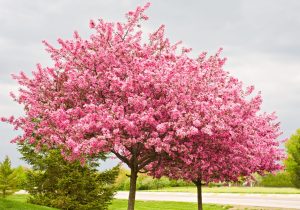
is called cosexual. Monoecious trees similarly have both male and female parts within the same tree, however they separate the male and female parts into different flowers or cones on the same tree. Dioecious trees separate male and female parts on completely different trees where one tree is strictly female and one strictly male. These trees were Ogren’s primary focus. And for completeness we will define polygamous trees as the most complex and as cosexual, with male and female flowers on the same tree but also with separate male and female parts in different combinations on completely different trees.
Ogren’s work focuses on dioecious males planted independently of dioecious females. This is often the case in urban areas due to the cleanliness concern described above. When this occurs however, their pollen is unchecked by any capture by female flowers and causing copious amount of pollen to be distributed in the air to cause coughing, sneezing, and respiratory issues. Tree pollen is one of the greatest offenders of not only allergic rhinitis, but also allergic conjunctivitis and allergic asthma as well.
Pollen Count Impact
Botanical sexism referenced higher pollen counts due to failed tree “gender balance”, and is further exacerbated by higher pollen potency. Studies have shown that air pollution (which tends to be higher in urban settings) attaches to pollen grains and causes the powdery substance to shatter into still tinier pieces. “When that happens the inside of the pollen grain is exposed and that’s 10 times more allergenic than the outside,” explained Ogren. This is again exacerbated by increasing CO2 levels which causes plants to bloom at a faster rate and at a higher content which means even higher pollen counts where predominantly male trees reside.
Purpose of Defining Botanical Sexism
Prime allergy season is usually defined as mid-March to early June in most of the United States. Frequency of allergic rhinitis (AR) diagnosis increase greatly during this season. AR affects more than 400 million people worldwide, and is expected to rise by another 100 million by 2025. Ogren collected extensive data, and by 2000 was able to develop a scale called OPALS (Ogren Plant Allergy Scale) that ranks more than 3,000 plants from 1 to 10 based on how allergenic they are. This was the first numerical ranking system in existence for plant allergies and is used to develop allergy rankings in large US cities.
Ogren’s work is meant to encourage city planners, plant distributors, and homeowners to think carefully about their plant choices. He feels we all are all responsible for the rising numbers of allergy sufferers, and we, by making the correct plant choices, can at least reduce the amount of allergenic pollen in the air. Examples of plants that are allergy-friendly include pansies, impatiens and snapdragons.
Amanda Hofmann, MPAS, PA-C, is a graduate of Duquesne University, in Pittsburgh, PA. After spending 8 years in clinical practice, she joined United Allergy Services where she is currently the Vice President of Clinical. Amanda is also the past president of the Association of PAs in Allergy, Asthma, and Immunology.
United Allergy Services is also on Facebook, LinkedIn, or Twitter. See other interesting and related articles on the UAS Blog.
Ragweed and Fall Pollen Allergies
Back to school season is here! Shorter days, crisp, cool evenings, and beautiful fall foliage are on the horizon. This time also marks the onset of weed pollination and the resurgence of allergy symptoms that may have taken a vacation in the hot, dry July heat. The meteorological calendar says fall begins September 22nd, but weed pollen, the main culprit of the sniffles and sneezes during fall allergy season, is already here!
Pollen Offenders
Towards the close of summer, weeds start to pollinate. Weeds grow all summer, but their pollen is usually not released until later in the growing season. This can vary year to year but typically starts mid to late August. Ragweed, cocklebur, lamb’s quarters, pigweed, dock sorrel, English plantain, and sagebrush can all cause fall allergy symptoms and are widely spread across the U.S.
Specifically ragweed pollen is the predominate culprit of allergy symptoms from August through October, peaking on average in mid-September. Ragweed is one of the major drivers of allergy symptoms and releases huge amounts of pollen each and every day. The pollen produced by ragweed is small and light. It is released in large quantities into the air and carried for miles by the wind. Nasal congestion, runny nose, and itchy eyes are typically caused by wind-blown pollen which is easily spread for miles and miles.
Other Pollen Types
Goldenrod, which blooms at the same time that ragweed does, is instead insect-pollinated and therefore is not a significant allergen for most individuals. Insect carried pollen is produced by plants that have bright and attractive flowers. This kind of pollen is typically large and heavy, sticks to insects, and is transported during flight fertilizing other plants. These bright flowers are commonly thought to be allergy offenders, however because they do not release much pollen into the air they are not as likely the culprit of allergy symptoms.
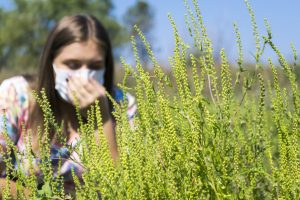
Manage Symptoms
Checking local pollen counts is helpful to anticipate the level of exposure on any given day. Pollen counts are determined by collecting pollen on special rods. The pollen is then counted under a microscope and calculated in grains per cubic meter of air. Pollen counts tend to be the highest early in the day, or often when the wind picks up just before a large rainstorm. If you like dancing in the fall rain, or jumping in rain puddles, however, you are in luck. During a rainstorm and immediately following, pollen becomes still and dormant because the rain makes it damp and heavy. As the air becomes warmer and drier following the storm, however, the pollen count will rise again.
Pollen Avoidance
Those with weed pollen allergies should try to avoid heavily dense wooded areas or those with brush and shrubbery. These areas should be especially avoided in late August when pollen is the most dense and abundant. Pollen counts are never zero, nor will an allergy sufferer truly be able to avoid weed pollen in the late summer and early fall. However, contact may be lessened by taking simple steps to avoid pollen overload:
- Utilizing the air conditioner or heater
- Keeping the windows and doors at home and in the car closed
- Utilizing the dryer rather than the fresh breeze to dry clothing
- Changing clothes after coming in from being outdoors
- Shower prior to getting into bed or laying on upholstered furniture
These easy steps will help to decrease pollen exposures. Also, one benefit COVID-19 may bring allergy sufferers, is that wearing of some masks will help to minimize the amount of pollen reaching the nasal passages if being worn in outdoor settings.
Get Tested
If someone is unsure whether weed pollen is a trigger for their back-to-school nasal congestion, runny nose, post nasal drip, sneezing, and itchy watery eyes, taking an allergy quiz or seeing their provider for an allergy test may provide the clarity they are looking for!
Amanda Hofmann, MPAS, PA-C, is a graduate of Duquesne University, in Pittsburgh, PA. After spending 8 years in clinical practice, she joined United Allergy Services where she is currently the Vice President of Clinical. Amanda is also the past president of the Association of PAs in Allergy, Asthma, and Immunology.
United Allergy Services is also on Facebook, LinkedIn, or Twitter. See other interesting and related articles on the UAS Blog.
Grass Pollen Allergy: Making the Most of Summer
Summer is finally here! Longer days, days spent by the beach or the pool, and late nights catching fireflies are on the horizon. Allergies are usually associated with the spring or fall because pollen is most active during these times. However, summer allergies, especially to grass, are also common. This grass pollen allergy can cause some of the same troublesome allergy symptoms as in other seasons.
Allergy Season
Grass begins to pollinate in the late spring, typically April or May in the northern part of the country. The pollination period in the north will then typically continue through June or July. However, in southern regions, grasses may pollinate throughout many seasons and could trigger symptoms throughout the year. These pollination time periods are when those who suffer from a grass pollen allergy notice their symptoms at their worst.
Types of Grass Pollen
There are hundreds of different kinds of grasses throughout the United States. Fortunately, not all of them are the source of summer sneezing, congestion, and itchy eyes. Some grass pollen types are small, light, dry and can travel for hundreds of miles by the wind. One group of grasses, referred to as the northern pasture grasses, cause more allergy problems than any others. These grasses include:
- common timothy grass
- sweet vernal grass
- orchard grass
- perennial rye grass
- Kentucky bluegrass
Another type of grass, bermuda, is a southern grass and is responsible for many troubling summer grass allergy symptoms. Johnson grass is another main culprit for grass pollen misery.
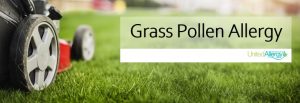
Options for Homeowners
While common Bermuda grass usually triggers allergies, some hybridized versions produce little to no pollen. One common type of hybrid Bermuda grass referred to as the "Princess 77" variety is available for homeowners. Other good hybrid Bermuda grass varieties include "Tifway" and "Santa Ana". Buffalo grass may be a good warmer climate option. This warm-season grass survives droughts and requires little supplemental watering, making it ideal for areas with watering restrictions. Types like the "UC Verde" or "609" produces only female plants, eliminating the problems of flowering and producing pollen. Although less commonly found, this is ideal for grass pollen sufferers.
Measuring Grass Pollen Counts
Those that suffer from a grass pollen allergy can benefit from checking their local pollen counts regularly. Pollen counts are determined collecting pollen on special rods. The pollen is then counted under a microscope. The pollen count is then calculated in grains per cubic meter of air. Pollen counts tend to be the highest early in the day, or often when the wind picks up just before a large rainstorm.
If you like dancing in the rain, or jumping in rain puddles, however, you are in luck. During a rainstorm and immediately following, pollen becomes still and dormant due to the rain making it damp and heavy. As the air becomes warm and dry following the storm, the pollen count will become potent again
Manage Your Grass Pollen Allergy
Pollen counts are never zero, nor will an allergy sufferer truly be able to avoid grass pollen in the summer. However, some practices may help decrease pollen exposures. For instance, utilizing the air conditioner while keeping the windows and doors to the home and car closed. Also, utilizing the dryer rather than the fresh breeze to dry clothing will help to decrease pollen exposures. It is especially important to keep windows closed when you or someone close mowing their grass.
Although it may seem like a good idea to avoid cutting the grass as much as possible, mowing grass often and keeping grass short actually causes the grass to release less pollen into the air. If a nonallergic friend or family member isn’t available to assist in cutting your grass, consider wearing a mask. Wearing masks will help to minimize the amount of pollen reaching the nasal passages. It is greatly beneficial for grass pollen sufferers to wear a mask when cutting grass or doing other yardwork.
Other Helpful Tips
Those with a grass pollen allergy should try to avoid heavily dense grassy areas, especially in early summer when pollen is the most dense and abundant. Although summer brings warmer temperatures. when you are out working in the yard, out at a park, or hiking it is recommended to wear long pants or long sleeve shirts in a light breathable fabric. This added layer of protection helps reduce the amount of pollen that comes in direct contact with your skin. Similarly, wearing sunglasses and hats also reduce pollen that contacts eyes or nestles in your hair.
Grass pollen allergy sufferers should also make a habit of changing their clothes after coming in from being outdoors, and bathing prior to getting into bed/laying on upholstered furniture. Wash bedding in very hot, sanitizing cycles once a week in peak pollen seasons. It is also beneficial to remove shoes before entering your home. And do not forget your pets! They can be major sources of tracking grass pollen into your home. Make sure to wipes them down with a wet cloth or towel before they enter your home, and make sure to bathe them more frequently in high pollen seasons. And although not always feasible, the ability to keep your pets from sleeping in your bed, in your bedroom, or on your upholstered furniture will also greatly benefit you if you suffer from grass pollen.
Symptom Relief is an Option
If someone is unsure whether grass pollen is a trigger for their troublesome nasal congestion, runny nose, postnasal drip, sneezing, and itchy watery eyes (take our allergy quiz here), seeing their provider for an allergy test may provide the clarity they are looking for!
Amanda Hofmann, MPAS, PA-C, is a graduate of Duquesne University, in Pittsburgh, PA. After spending 8 years in clinical practice, she joined United Allergy Services where she is currently the Vice President of Clinical. Amanda is also the past president of the Association of PAs in Allergy, Asthma, and Immunology.
United Allergy Services is also on Facebook, LinkedIn, or Twitter. See other interesting and related articles on the UAS Blog.

